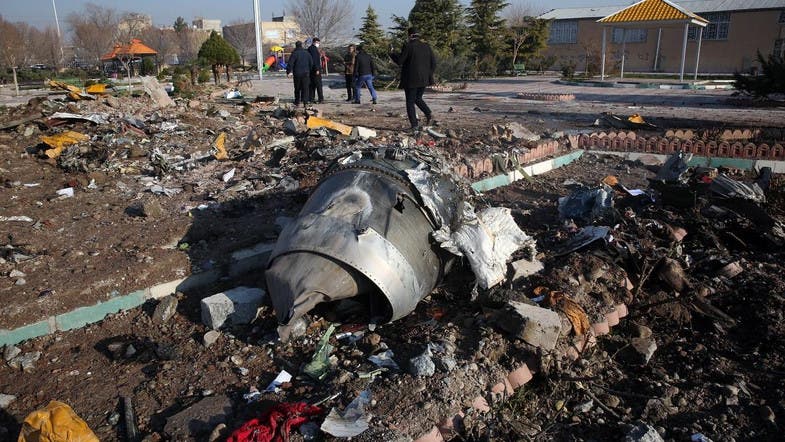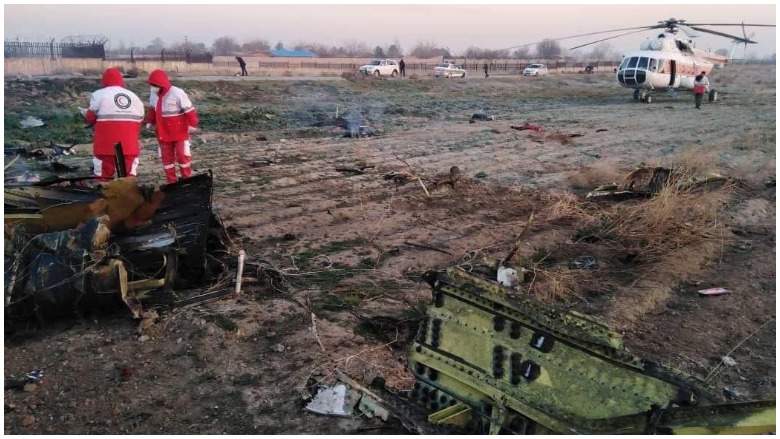نيوزويك عن 3 مسؤولين: صاروخ إيراني أسقط طائرة أوكرانيا
دبي – العربية.نت، وكالات/09 كانون الثاني/2020
US officials: ‘Highly likely’ Iran downed Ukrainian jetliner
The Canadian Press/January 9, 2020
Iranian Missile Shot Down Ukranian Flight Probably By Mistake, Sources Say.
By Naveed Jamali , James LaPorta , Chantal Da Silva and Tom O’Connor Newsweek/January 09/2020
======================
US officials: ‘Highly likely’ Iran downed Ukrainian jetliner
The Canadian Press/January 9, 2020
WASHINGTON — Two U.S. officials said Thursday it was “highly likely” that an Iranian anti-aircraft missile downed a Ukrainian jetliner late Tuesday, killing all 176 people on board.
The crash came just a few hours after Iran launched a ballistic missile attack against Iraqi military bases housing U.S. troops amid a confrontation with Washington over the U.S. drone strike that killed an Iranian Revolutionary Guard general last week. The officials, citing U.S. intelligence, spoke on the condition of anonymity to discuss sensitive information. They said they had no certain knowledge of Iranian intent. But they said it could very well have been a mistake, and that the airliner was mistaken for a threat.
President Donald Trump suggested that he believes Iran was responsible and wouldn’t directly lay the blame on Iran, but dismissed Iran’s initial claim that it was a mechanical issue.
“Somebody could have made a mistake on the other side.,” Trump said, noting the plane was flying in a “pretty rough neighbourhood .”“Some people say it was mechanical,” Trump added. “I personally don’t think that’s even a question.”
The U.S. officials wouldn’t say what intelligence they have that points to an Iranian missile. But they acknowledged the existence of satellites and other sensors in the region, as well as the likelihood of communications intercepts and other similar intelligence.
The U.S. assessment comes after a preliminary Iranian investigative report released Thursday said the pilots never made a radio call for help and claimed the aircraft was trying to turn back for the airport when the burning plane went down. Ukraine, meanwhile, said it considered a missile strike as one of several possible theories for the crash, despite Iran’s denials.
The Iranian report suggests that a sudden emergency struck the Boeing 737 operated by Ukrainian International Airlines late Tuesday, when it crashed, just minutes after taking off from Imam Khomeini International Airport in Tehran.
Investigators from Iran’s Civil Aviation Organization offered no immediate explanation for the disaster, however. Iranian officials initially blamed a technical malfunction for the crash, something initially backed by Ukrainian officials before they said they wouldn’t speculate amid an ongoing investigation.
The Ukrainian International Airlines took off at 6:12 a.m. Wednesday, Tehran time, after nearly an hour’s delay at Tehran’s Imam Khomeini Airport, the main airport for travellers in Iran. It gained altitude heading west, reaching nearly 8,000 feet, according to both the report and flight-tracking data.
Then something went wrong, though “no radio messages were received from the pilot regarding unusual situations,” the report said. In emergencies, pilots reach out to air-traffic controllers to warn them and to clear the runway for their arrival, though their first priority is to keep the aircraft flying.
Eyewitnesses, including the crew of another flight passing above it, described seeing the plane engulfed in flames before crashing at 6:18 a.m., the report said. Flight-tracking data for the plane stopped before the crash, which occurred in the town of Shahedshahr to the northeast of the plane’s last reported position. That’s the wrong direction of the flight plan, bolstering the report’s claim that the pilots tried to turn the aircraft back to the airport.
The crash caused a massive explosion when the plane hit the ground, likely because the aircraft had been fully loaded with fuel for the flight to Kyiv, Ukraine.
The report also confirmed that both of the so-called “black boxes” that contain data and cockpit communications from the plane had been recovered, though they sustained damage and some parts of their memory was lost. It also said that investigators have initially ruled out laser or electromagnetic interference as causing the crash.
Hours before the plane crash the U.S. Federal Aviation Administration had issued an emergency flight restriction barring U.S. carriers and pilots from flying over areas of Iraqi, Iranian and some Persian Gulf airspace warning of the “potential for miscalculation or mis-identification” for civilian aircraft due to heightened political and military tensions.
Oleksiy Danilov, secretary of Ukraine’s Security Council, told Ukrainian media that officials had several working theories regarding the crash, including a missile strike.
Iranian Missile Shot Down Ukranian Flight Probably By Mistake, Sources Say.
By Naveed Jamali , James LaPorta , Chantal Da Silva and Tom O’Connor Newsweek/January 09/2020
The Ukrainian flight that crashed just outside the Iranian capital of Tehran was struck by an anti-aircraft missile system, a Pentagon official, a senior U.S. intelligence official and an Iraqi intelligence official told Newsweek.
Ukraine International Airlines Flight 752, a Boeing 737–800 en route from Tehran Imam Khomeini International Airpot to Kyiv’s Boryspil International Airport, stopped transmitting data Tuesday just minutes after takeoff and not long after Iran launched missiles at military bases housing U.S. and allied forces in neighboring Iraq. The aircraft is believed to have been struck by a Russia-built Tor-M1 surface-to-air missile system, known to NATO as Gauntlet, the three officials, who were not authorized to speak publicly on the matter, told Newsweek.
One Pentagon and one U.S senior intelligence official told Newsweek that the Pentagon’s assessment is that the incident was accidental. Iran’s anti-aircraft were likely active following the country’s missile attack, which came in response to the U.S. killing last week of Revolutionary Guard Quds Force commander Major General Qassem Soleimani, sources said.
Of the 176 people on board, 82 were Iranian, 63 were Canadian and 11 were Ukrainian (including nine crewmembers), along with 10 Swedish, seven Afghan and three German nationals. None survived.
The incident was first reported by Iranian semi-official media outlets, which cited the country’s Red Crescent Society as assessing that the initial cause appeared to be mechanical failure. The Ukrainian embassy in Tehran shared this view in a statement, but later retracted it, with Kyiv warning not to draw conclusions from preliminary assessments.
Images began to circulate Wednesday of what appeared to be fragments of a Tor M-1 missile said to have been found in a suburb southwest of Tehran. Ukraine Security Council Secretary Oleksiy Danylov said Thursday in a statement that contact with a Tor M-1 system was among the potential causes for the plane’s destruction that his country was looking into.
Other potential scenarios involved a collision with an unmanned aerial vehicle (UAV) or another flying object, technical malfunction and a terrorist attack.
The Civil Aviation Organization of Iran Chief has also invited Canada and Sweden to cooperate in the accident investigation, however, Chief Executive Ali Abedzadeh has stressed that he would not hand over the aircraft’s black box—which may provide details of the doomed flight’s final moments—to the United States.
Abedzadeh also on Thursday dismissed speculation that a missile strike took down. In a statement, he said this outcome was “scientifically impossible and such rumors make no sense at all.”
In a rare call Thursday, Canadian Foreign Minister Francois-Philippe Champagne spoke with his Iranian counterpart Mohammad Javad Zarif, to whom he “stressed the need for Canadian officials to be quickly granted access to Iran to provide consular services, help with identification of the deceased and take part in the investigation of the crash.”
Champagne said that “Canada and Canadians have many questions which will need to be answered.”
Asked whether the Canadian government is considering or leading with the possibility that an anti-aircraft missile took down Ukraine International Airlines Flight 752, Global Affairs spokesperson Krystyna Dodds said her office would have to get back to Newsweek on the matter.
https://www.newsweek.com/iranians-shot-down-ukraine-flight-mistake-sources-1481313?amp=1&__twitter_impression=true
نيوزويك عن 3 مسؤولين: صاروخ إيراني أسقط طائرة أوكرانيا
دبي – العربية.نت، وكالات/09 كانون الثاني/2020
كشفت مجلة “نيوزويك” الأميركية أن الطائرة الأوكرانية التي سقطت قرب طهران أصيبت بصواريخ إيرانية أطلقت من نظام مضاد للطائرات تم تفعيله عن طريق الخطأ، وفق 3 مسؤولين من وزارة الدفاع الأميركية (البنتاغون) والاستخبارات الأميركية والعراق.
ونقلت المجلة عن المسؤولين الثلاثة، الذين رفضوا الكشف عن هوياتهم، أن الأنظمة الإيرانية المضادة للطائرات كانت في حالة استنفار في توقيت تحطم الطائرة، وذلك بعد وقت قليل من إطلاق إيران صواريخ روسية الصنع على قاعدتين بالعراق بهما قوات أميركية رداً على اغتيال واشنطن لقائد فيلق القدس في الحرس الثوري الإيراني، الجنرال قاسم سليماني، في بغداد.
ورجح المسؤولون الثلاثة للمجلة أن الطائرة قصفها نظام صواريخ أرض جو Tor-M1 صنعته روسيا، ويُعرف لدى حلف شمال الأطلسي (ناتو) باسم Gauntlet.
وإلى ذلك، أفاد بيان أن وزير الخارجية الكندي أجرى اتصالاً نادراً مع نظيره الإيراني للتشديد على رغبة بلاده في التحقيق في تحطم طائرة للخطوط الأوكرانية، الأربعاء، في إيران، مما أدى لمقتل 176 شخصاً، بينهم 63 كندياً.
وبحسب البيان، “شدد الوزير على الحاجة إلى سرعة السماح لمسؤولين كنديين بدخول إيران لتقديم خدمات قنصلية والمساعدة في تحديد هوية الضحايا والمشاركة في التحقيق في التحطم. وأضاف البيان: “لدى كندا والكنديين أسئلة كثيرة تحتاج إلى الإجابة عنها”.
وتحدث الوزيران في وقت متأخر من مساء الأربعاء، لكن البيان صدر، الخميس. ولا ترتبط كندا بعلاقات دبلوماسية مع إيران منذ 2012.
كما طلب الرئيس الأوكراني، فولوديمير زيلينسكي، من بريطانيا مساعدته على المشاركة في تحقيقات تحطم الطائرة.
هذا وأعلنت منظمة الطيران المدني الإيرانية أن طائرة الخطوط الجوية الأوكرانية الدولية من طراز “بوينغ737” التي تحطّمت الأربعاء في طهران، وأدى الحادث إلى مقتل جميع ركاب الطائرة البالغ عددهم 176 شخصاً، استدارت للعودة بعدما واجهت “مشكلة”.
وأفادت المنظمة في تقرير مبدئي نشرته على موقعها الإلكتروني، الخميس، أن “الطائرة التي كانت تتجه في البداية غربا للخروج من منطقة المطار، استدارت إلى اليمين بعدما واجهت مشكلة وكانت تتوجه للعودة إلى المطار وقت وقوع الحادث”.
وذكر التقرير أنه بعد قليل من إقلاع الطائرة من طهران، أمس الأربعاء، اشتعلت النيران بها.
وأشار التقرير إلى أقوال شهود على الأرض، وفي طائرة كانت تحلق على ارتفاع عال، ذكروا فيها أن النيران كانت ناشبة في الطائرة وهي في الجو.
وأفاد التقرير المبدئي أن قائد الطائرة لم يجر اتصالا لاسلكيا يبلغ فيه بحدوث موقف غير معتاد. كما أكد التقرير العثور على الصندوقين الأسودين للطائرة، على الرغم من تعرضهما للتلف وفقدان بعض أجزاء ذاكرتيهما. وقال أيضا إن المحققين استبعدوا في البداية الليزر أو التداخل الكهرومغناطيسي كسبب في الحادث.
وأضاف المحققون أن النيران التهمت الطائرة بالكامل قبل تحطمها. وذكروا أن التحطم جاء بسبب انفجار هائل عندما اصطدمت الطائرة بالأرض، وذلك، لأنها كانت مملوءة بالوقود بشكل كامل من أجل الوصول إلى كييف مباشرة.
التقرير أوضح كذلك أن المحققين الإيرانيين أرسلوا المعلومات الأولية عن الحادث إلى أوكرانيا والولايات المتحدة والسويد وكندا. وكان الرئيس الأوكراني قال إن محققين من بلاده وصلوا إلى إيران للمساعدة في التحقيق. وأضاف أنه يعتزم الاتصال بالرئيس الإيراني حسن روحاني بشأن الحادث.
وتابع “بلا شك، فإن الأولوية بالنسبة لأوكرانيا هي تحديد أسباب تحطم الطائرة. بالتأكيد سنكتشف الحقيقة”. كانت الطائرة تقل 167 راكباً من عدة دول و9 من أفراد الطاقم. وكان من بين القتلى 82 إيرانيا وما لا يقل عن 63 كنديا و11 أوكرانيا، وفقا للمسؤولين.
وأدى تحطم الطائرة قبيل طلوع الفجر إلى تناثر الحطام ومتعلقات الركاب عبر مساحة واسعة من الأراضي الزراعية. كما وقع مباشرة بعد أن شنت إيران هجوما صاروخيا باليستيا على قواعد عسكرية عراقية تضم قوات أميركية وسط مواجهة مع واشنطن بشأن مقتل قائد فيلق القدس التابع للحرس الثوري الإيراني، قاسم سليماني، في غارة جوية أميركية بطائرة بدون طيار الأسبوع الماضي.
























